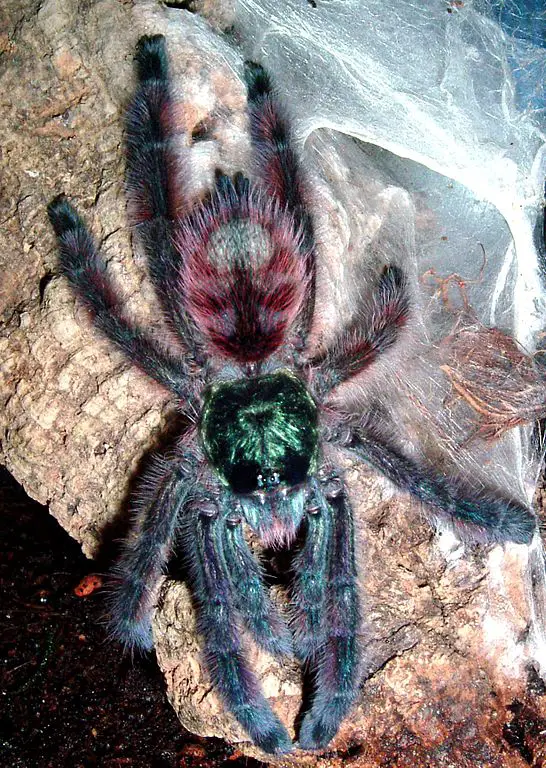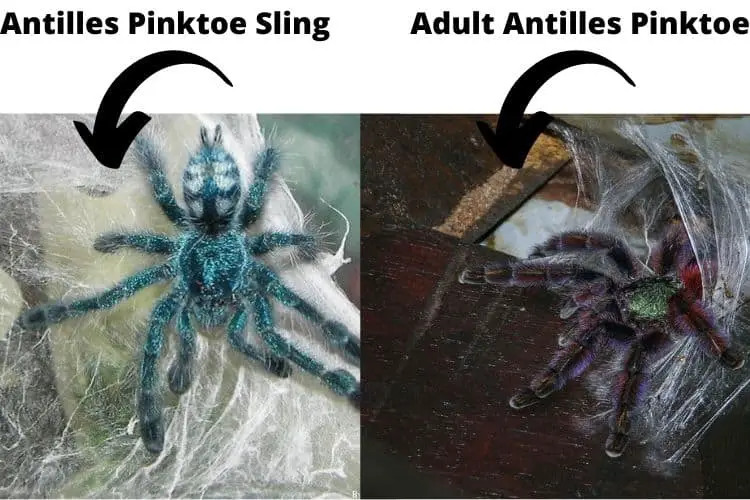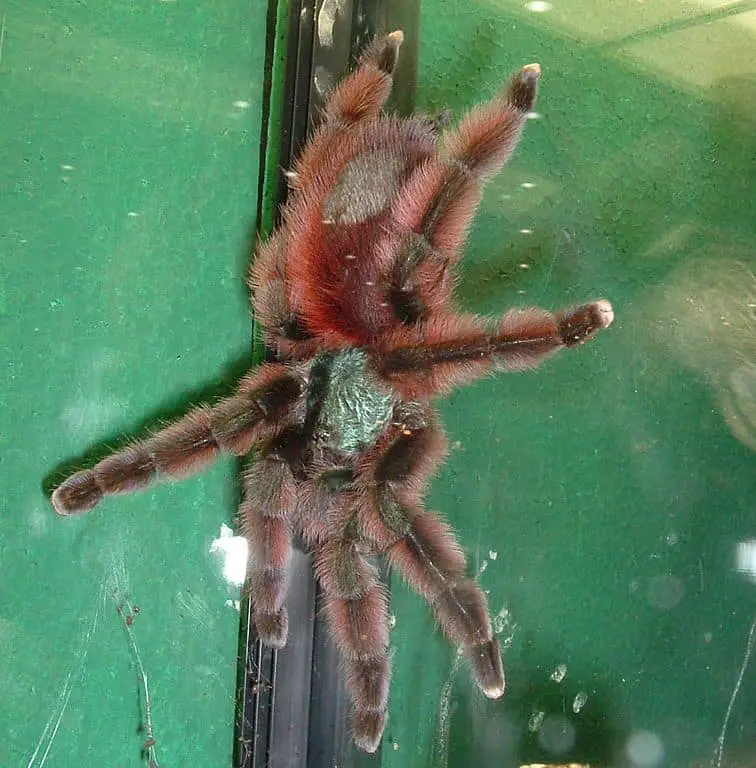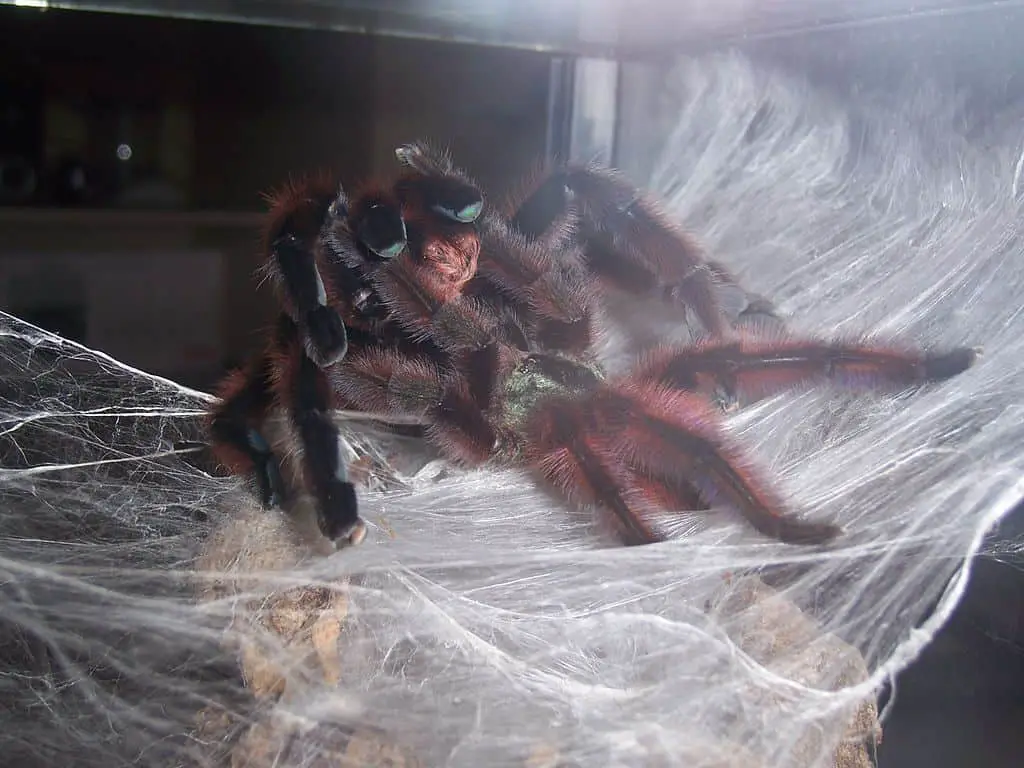The Antilles Pinktoe Tarantula (Caribena Versicolor) is an Arboreal New World Tarantula that’s incredibly popular among tarantula lovers. It has a stunning green carapace with a reddish abdomen and green legs with pink tarsi (toes). They are covered with purple hairs which give the spider its characteristic pink hue. They can grow to a size of up to 6 inches
If you’re considering taking an Antilles Pinktoe tarantula into your home you’ve come to the right place. In this article, we’ll go over everything you need to know about this fantastic tarantula species to help you make a well-informed decision on whether or not this spider is right for you.
Antilles Pinktoe Care Sheet
| Name of species | Caribena Versicolor |
| Family | Theraphosidae |
| Experience level | Beginner |
| Category | New World |
| Type | Arboreal |
| Temperature requirement | 75 to 85 degrees Fahrenheit |
| Temperament | Calm, docile |
| Color | Multicolor; green, reddish, pink |
| Native location | Caribbean |
| Lifespan | Males 2-3 years; females 8-12 years |
| Size | 6″ |
| Diet | Insects: crickets, roaches, mealworms |
| Minimum tank size | 12”x12”x18” |
Antilles Pinktoe Tarantula Overview

The Antilles Pinktoe tarantula is native to the island of Martinique in the Antilles. It’s an arboreal tarantula, which means that in the wild it spends the majority of its time in the trees. They spin elaborate funnel webs which they use as homes.
This species has a mild venom, which is usually no worse than a bee sting. Luckily, they’re quite docile, so bites do not happen very often.
Like other New World spiders, the Antilles Pinktoe has urticating hairs which they can throw when they feel threatened. These urticating hairs can cause irritation and redness if they make contact with your skin.
Appearance and Varieties

The Antilles Pinktoe Tarantula looks quite different as a baby compared to when it’s fully grown. The babies are blue in color. However, as they grow older, their color changes gradually. Over time, they lose their blue color. Their carapace turns green, the abdomen red, and the legs become green with pink tarsi.
Like with most tarantulas, males are quite a bit smaller than females, especially in their abdomens. However, what the males lack in size, they often make up for in color, as they’re often more brightly colored than females.
Price
The price of an Antilles Pinktoe Tarantula is typically between $40 and $160. The price depends on a few factors. First, males are typically cheaper than females. This makes sense because females live about 3 times as long. Secondly, the price depends a lot on the breeder that you purchase from. Some breeders charge higher prices than others.
Of course, you’ll also have to factor in the fact that you have to purchase a terrarium, although they can be quite cheap at about $30, substrate, a water dish, some decoration, and food.
On the whole, expect to spend about $100 on the tarantula if you buy it from a breeder, $80 on initial costs, and <$10 ongoing costs per month for vet visits, food, and other costs.
Antilles Pinktoe Slings are often cheaper to buy but are not recommended for beginners to the hobby because they’re much more difficult to care for than adults.
Behavior and Temperament

The Antilles Pinktoe Tarantula is typically described as being docile, calm, and easy to care for. This makes them an excellent species for beginners.
However, they do have a tendency to jump, which some people misinterpret as them being flighty. Tarantulas in general do not really enjoy being handled, but the Antilles Pinktoe is quite receptive to it and often tolerates it quite well.
Since they’re a new world species, their venom is quite mild. However, they do have urticating hairs which they can release when they feel threatened. Make sure that you do not get these hairs in your eyes, as that can result in you ending up in the hospital. These hairs can also end up on your hands when you handle them, so make sure that you wash your hands carefully after handling them to avoid spreading the hairs to your face and eyes.
These tarantulas are solitary, so make sure that you never house two of them together as this will not go well.
How to care for an Antilles Pinktoe Tarantula
Tank size
Your Antilles Pinktoe tarantula needs a tank that’s at minimum 12 by 12 by 18 inches in size or about 10 gallons. This can easily house a single adult. When selecting an enclosure, height is more important than width because they’re an arboreal species that spend the majority of their time in the trees.
The best choice is an enclosure that has a front or side-facing door. The reason is that a door at the top of their cage will constantly destroy their webs which is agitating and stressful for the spider. On top of that, a door on the top will make it much easier for them to escape.
Humidity
The optimal humidity level for an Antilles Pinktoe Tarantula is between 75 and 80%, which is close to the humidity levels they enjoy in the wild. Having adequate humidity is important for the general well-being of your tarantula and helps them to molt more easily.
If you’re struggling to increase the humidity to the desired level, try dampening the substrate or placing a larger water bowl in their enclosure so that the evaporation will make the air more humid.
Ventilation
Ventilation is very important for the Antilles Pinktoe tarantula, perhaps even more so than humidity. It makes sense why because these spiders lived in the trees near the sea which means that they always had a lot of wind and thus a lot of air circulation.
To ensure that their enclosure is ventilated enough, you can drill small holes or mesh on each side of their enclosure. This will allow the air to flow through. Make sure that you only drill the holes on the side, not on the top. Humid air floats to the top, so drilling holes in the top will reduce humidity which is not something you want.
Temperature
The ideal temperature for the Antilles Pinktoe to thrive is between 75 and 85 degrees Fahrenheit. To achieve this temperature you can use a low-powered heating pad and a thermostat.
It’s been noted that this species is more active at higher temperatures, but make sure not to overdo it. A temperature that’s too high or too low can negatively affect your spider.
Substrate
The best substrate for the Antilles Pinktoe tarantula is coconut fibers because it’s good at retaining moisture which can help with the humidity in their enclosure. They need about 4 to 5 inches of substrate in their terrarium.
Foliage & Decor
Adding foliage to your Antilles Pinktoe’s enclosure is important because they’re an arboreal spider. As such, they do not burrow, but instead, create their homes by making a funnel web between leaves and foliage.
Feeding
Like other tarantulas, the Antilles Pinktoe feeds on insects such as crickets, roaches, and mealworms. These insects are easy to buy from your local pet or reptile supply store but you can also grow them yourself.
An average adult needs 2-3 large crickets or roaches per week, but this does differ between individuals. Some are more active and thus need more food.
If you notice that their abdomen is getting too large, feed them less often, if you notice that it’s too small, feed them more often. You can spice up their regular cricket and roach diet by occasionally feeding them a mealworm.
Gut-loading the prey insects is often done to ensure that your tarantula gets the optimal nutrition.
Prey items should be captive-bred. Wild-caught prey insects can contain parasites that are harmful to the Antilles Pinktoe Tarantula.
Communal living
The Antilles Pinktoe tarantula is not a communal species. They should not be housed with other tarantulas because that will result in cannibalism.
If you want to keep tarantulas communally check out the Trinidad Olive Tarantula or the Socotra Blue Baboon instead.
Health and Lifespan
Antilles Pinktoe tarantulas do not have any notable health issues that you need to be wary of. They’re a healthy species that do have predators in the wild, but in captivity, they do not have much to fear. Because of this, they typically have long lifespans, especially females.
Females can live for up to 12 years, whereas males usually live for 2 to 3 years.
To keep them healthy and in good condition, it’s important that their enclosure has enough ventilation to avoid mold and bacterial growth. In addition, you should remove uneaten food and shed exoskeletons in a timely matter.
Breeding

If you plan to breed the Antilles Pinktoe it’s best to do so a month or so after the female molts. Before you pair the male and female together make sure that the female is well-fed.
Begin by placing the two tarantulas in separate terrariums near each other so that they can see one another. After a few days, place them in a terrarium together to allow them to breed. When the breeding is done, move them back to their own enclosures quickly.
After a few weeks, the female will create an egg sac and lay a large number of eggs. She will guard these eggs fiercely and a few weeks after dozens/hundreds of spiderlings will be born.
Breeding is not something that you should do if you have no experience. The end result is that you have many baby tarantulas that can be difficult to find good homes for. It’s best to leave the breeding to the experts.
Facts about the Antilles Pinktoe tarantula
- The Caribena Versicolor was first described in 1837 by Charles Athanase Walckenaer. When he first described them he accidentally described two different species.
- Antilles Pinktoe Tarantula slings look very different from adults in color
Final words: Is the Antilles Pinktoe Tarantula Right for you?
If you’re new to the Tarantula husbandry world then the Antilles Pinktoe is a great introductory species. Their docile and calm nature makes them a great species that allow you to familiarize yourself with the world of tarantula husbandry and their beautiful appearance is sure to steal the hearts of anyone who sees it.
Even for more experienced keepers, this species has a lot to offer. They’re easy to care for and an absolute stunner to add to your collection.
- How Long Do American Eskimo Dogs Live? Important Factors and Care Tips - September 29, 2023
- Do American Bulldogs Need Grooming? Essential Tips and Care Guidelines - September 29, 2023
- Do Bengal Cats Enjoy Playing? Essential Tips for Keeping Them Active - September 29, 2023